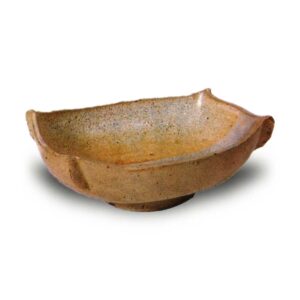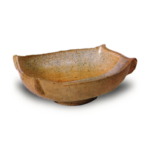
Pottery from Hagi, Nagato Province (Yamaguchi Prefecture). Around the Kanbun period (1661-73), Kibei Miwa of Yamato Miwa (whose family name was later changed to Miwa) came to Hagi and engaged in pottery production in the service of the Mori clan, the feudal lord of the domain. He was given the title of “Kyusetsu” by the Mori clan and built a kiln in Matsumoto, where he produced both Raku ware and Hagi-yaki ware. His works are characterized by their dense clay and pale white glaze with blue tints, and always have a pool of glaze where the glaze stops. Matsumoto hagi and Matsumoto ware by Kyusetsu are called Matsumoto hagi and Matsumoto ware to distinguish them from the old Hagi ware, but the general public refers to Matsumoto hagi as well as Saka-gama. The son Yahei became a disciple of the Saka family of Hagi ware at the behest of the feudal lord. In 1885 (Meiji 18), Kyusetsu was the eighth generation. It is said that one of the characteristics of Matsumoto pottery is that small cracks appear in the white glaze over the painted surface, which is made by applying gosu (mineral pigment) to the surface of a pressed mold. However, Matsumoto ware and hon are merely divisions of an era, and when they are introduced to the world, they are uniformly referred to as Hagi-yaki ware. (Appendix of Pottery Reviews, Novelizations of Honcho Pottery, Tea Ceremony Senje, Kogei Shiryo, Three Prefectural Pottery Traditions of Potters, Kogei Kagami, Pottery Anthology, History of Ceramics in Japan)








